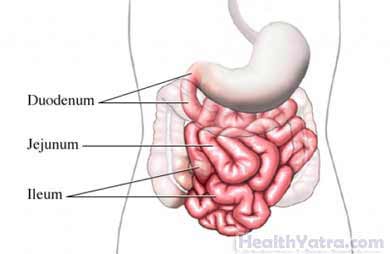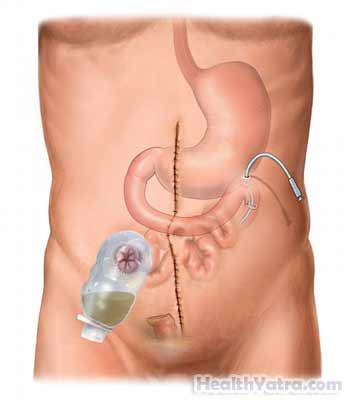সংজ্ঞা
A small bowel resection is the removal of part of the small intestine. The small intestine includes the duodenum, jejunum, and ileum. The surgery can be done through an open incision or using smaller incisions.

পদ্ধতির কারণ
This procedure may be done to treat the following conditions:
- Bleeding, infection, or ulcers in the small intestines
- ক্যান্সার
- Precancerous polyps
- ক্রোনের রোগ
- Intestinal blockage
- আঘাত
সম্ভাব্য জটিলতা
Complications are rare, but no procedure is completely free of risk. If you are planning to have a resection, your doctor will review a list of possible complications, which may include:
- অত্যধিক রক্তপাত
- সংক্রমণ
- Blockage of the intestine caused by scar tissue
- ছেদ জায়গায় হার্নিয়া গঠন
জটিলতার ঝুঁকি বাড়াতে পারে এমন কারণগুলির মধ্যে রয়েছে:
- ধূমপান
- Previous abdominal surgery
- অপুষ্টি
- দীর্ঘস্থায়ী অসুখ
- ড্রাগ ব্যবহার
কি আশা করছ
পদ্ধতির আগে
আপনার ডাক্তার নিম্নলিখিত করতে পারেন:
- শারীরিক পরীক্ষা
- রক্ত এবং প্রস্রাব পরীক্ষা
- X-rays of the chest and abdomen
- পেটের সিটি স্ক্যান
আপনার পদ্ধতি পর্যন্ত নেতৃত্ব:
- আপনার ওষুধ সম্পর্কে আপনার ডাক্তারের সঙ্গে কথা বলুন। পদ্ধতির এক সপ্তাহ আগে আপনাকে কিছু ওষুধ খাওয়া বন্ধ করতে বলা হতে পারে, যেমন:
- অ্যাসপিরিন বা অন্যান্য প্রদাহ বিরোধী ওষুধ
- রক্ত পাতলা করে
- Take medicines as recommended by your doctor. This may include antibiotics.
- Your intestines should be cleaned out for the surgery. During the week before surgery, eat high-fiber foods and drink plenty of water. This will encourage bowel movements. Other cleansing methods may also be recommended, including enemas, laxatives, and a clear-liquid diet. You may be asked to drink a large container of solution that helps with the complete emptying of your intestines.
- Begin fasting as directed by your doctor.
এনেস্থেশিয়া
General anesthesia will be given. You will be asleep.
পদ্ধতির বর্ণনা
The procedure may be done with one of two methods:
- Traditional open incision—An incision will be made into the abdomen in the area of the diseased intestine.
- Laparoscopic technique—A few small incisions will be made in the abdomen. Carbon dioxide gas will be pumped into the abdomen through an incision. A laparoscope, which is a thin tube with a small camera on the end, will be inserted through the incisions. Special tools will also be inserted through these incisions. The laparoscope sends a view of the interior of the abdomen to a video monitor.
In either অস্ত্রোপচারের ধরন, the small intestine will be clamped above and below the diseased section. This section will be cut free and removed.
If there is enough healthy intestine left, the free ends of the intestine may be joined together. Otherwise, a permanent or temporary ileostomy is created. An ileostomy is an opening called a stoma in the abdomen. The end of the small intestine closest to the stomach is attached to the opening. This allows intestinal contents to drain into a sealed pouch on the outside of the body. If a temporary ileostomy is created, another operation will be necessary several months later to reverse it.

The abdomen incisions will be closed with stitches.
এতে কতক্ষণ সময় লাগবে?
About 1-4 hours
এটা কতটা আঘাত করবে?
Anesthesia prevents pain during the procedure. Talk to your doctor about medicine to help manage the pain in recovery.
গড় হাসপাতালে থাকার
The usual length of stay is 5-7 days. Your doctor may choose to keep you longer if complications arise.
পোস্ট-প্রক্রিয়া যত্ন
হাসপাতালে
A catheter will be placed in your bladder before surgery. You will also have a nasogastric tube. This is a small tube that goes in through your nose and down into your stomach. The tube may be used to drain fluids from your stomach or to help deliver food to your stomach. The catheter and tube will remain until you are able to eat and go to the bathroom normally.
ঘরে
When you return home, do the following to help ensure a smooth recovery:
- Your doctor will tell you when you can resume your normal activities.
- Check with you doctor about doing any heavy lifting or tiring activities.
- Do not drive unless your doctor has given you permission to do so.
- কখন গোসল করা, গোসল করা বা জলে ভিজানো নিরাপদ সে সম্পর্কে আপনার ডাক্তারকে জিজ্ঞাসা করুন।
- Exercise your legs while in bed to prevent blood clots.
- If you go home with an ileostomy, you will receive instructions on how to change the bag and maintain personal hygiene.
- আপনার ডাক্তারের নির্দেশাবলী অনুসরণ করতে ভুলবেন না।
আপনার ডাক্তারকে কল করুন
আপনি হাসপাতাল ছেড়ে যাওয়ার পরে, নিম্নলিখিতগুলির মধ্যে যেকোনটি ঘটলে আপনার ডাক্তারের সাথে যোগাযোগ করুন:
- জ্বর এবং ঠাণ্ডা সহ সংক্রমণের লক্ষণ
- Any redness, swelling, bleeding, or drainage from the incision site
- Your bandage becomes soaked with blood
- Stitches or staples come apart
- বমি বমি ভাব এবং/অথবা বমি যা আপনি অস্ত্রোপচারের পরে দেওয়া ওষুধ দিয়ে নিয়ন্ত্রণ করতে পারবেন না, বা যা হাসপাতাল থেকে ছাড়ার পরে দুই দিনের বেশি সময় ধরে থাকে
- Persistent abdominal pain or bloating
- কোষ্ঠকাঠিন্য বা ডায়রিয়া
- Rectal bleeding or tarry-colored stools
- ব্যথা যা আপনি ওষুধ দিয়ে নিয়ন্ত্রণ করতে পারবেন না
- কাশি, শ্বাসকষ্ট বা বুকে ব্যথা
- ব্যথা, জ্বালা, জরুরী, প্রস্রাবের ফ্রিকোয়েন্সি, বা প্রস্রাবে অবিরাম রক্ত
- New symptoms
জরুরী পরিস্থিতিতে, অবিলম্বে চিকিৎসা সহায়তার জন্য কল করুন।
